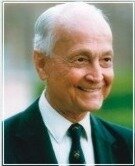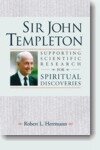Biography: Sir John Templeton
John Marks Templeton, the pioneer global investor who founded the Templeton Mutual Funds and for the past three decades devoted his fortune to his Foundation’s work on the “Big Questions” of science, religion, and human purpose, passed away on July 8, 2008, at Doctors Hospital in Nassau, Bahamas, of pneumonia.
As a pioneer in both financial investments and philanthropy, John Templeton spent a lifetime encouraging open-mindedness. If he hadn’t sought new paths, he once said, “he would have been unable to attain so many goals.” The motto that Templeton created for his Foundation, “How little we know, how eager to learn,” exemplified his philosophy in the financial markets and his groundbreaking methods of philanthropy.
Templeton started his Wall Street career in 1937 and went on to create some of the world’s largest and most successful international investment funds. Called by Money magazine “arguably the greatest global stock picker of the century” (January 1999), he sold the Templeton Funds in 1992 to the Franklin Group for $440 million.
A naturalized British citizen who lived in Nassau, the Bahamas, Templeton was created a Knight Bachelor by Queen Elizabeth II in 1987 for his many philanthropic accomplishments, including his endowment of the former Oxford Centre for Management Studies as a full college, Templeton College, at the University of Oxford in 1983.
In 1972, he established the world’s largest annual award given to an individual, the £1,000,000 Templeton Prize, which is announced in New York and presented in London. The Prize is intended to recognize exemplary achievement in work related to life’s spiritual dimension. Its monetary value always exceeds that of the Nobel Prizes—Templeton’s way of underscoring his belief that advances in the spiritual domain are no less important than those in other areas of human endeavor.
Templeton contributed a sizable amount of his fortune to the John Templeton Foundation, established in 1987 and based in West Conshohocken, Pennsylvania. The Foundation currently awards millions of dollars in annual grants. The Foundation’s mission is to serve as a philanthropic catalyst for research on what scientists and philosophers call the “Big Questions.” This vision is derived from Templeton’s belief that rigorous research and cutting-edge science are at the heart of human progress.
Templeton’s progressive ideas on finance, faith, and spirituality made him a distinctive figure in both fields, but the soft-spoken Southerner never worried about being an iconoclast. “Rarely does a conservative become a hero of history,” he observed in his 1981 book, The Humble Approach, one of more than a dozen books he wrote or edited.
Taking a less-traveled route in investing, Templeton provided advice on how to invest worldwide when Americans rarely considered foreign investment. While standard stock-buying advice is “buy low, sell high, ” Templeton took the strategy to an extreme, picking nations, industries, and companies hitting rock-bottom, what he called “points of maximum pessimism. ” When war began in Europe in 1939, he borrowed money to buy 100 shares each in 104 companies selling at one dollar per share or less, including 34 companies that were in bankruptcy. Only four turned out to be worthless, and he turned large profits on the others after holding each for an average of four years.
After beginning his career on Wall Street in 1937, Templeton bought a small investment advisory concern in 1940 that became Templeton, Dobbrow and Vance, Inc. He entered the mutual fund industry in 1954 when he established the Templeton Growth Fund.
In 1956 Templeton joined with marketing consultant William Damroth to launch the Nucleonics, Chemistry, and Electronics Fund, a specialty fund that reflected Templeton’s lifelong interest in science and technology. With investor interest in specialty funds rising in the late 1950s, Templeton Damroth’s new fund grew dramatically.
Templeton sold his stake in Templeton Damroth in 1962, and over the next three decades created some of the world’s largest and most successful international investment funds. Each $10,000 invested in the Templeton Growth Fund Class A in 1954, with dividends reinvested, would have grown to $2 million by 1992 when Sir John sold the Templeton Growth Fund. This translates into an annualized return of 14.5% since inception.
During a career that included directorships on banks, businesses, and insurance companies, Templeton maintained a long association with the Presbyterian Church (U.S.A.). He was a trustee on the board of Princeton Theological Seminary, the largest Presbyterian seminary, for 42 years and served as its chair for 12 years. He also lent his business acumen to the Presbyterians’ ministerial pension fund for more than three decades until 1993.
Templeton was known for starting his mutual fund’s annual meetings with a prayer. He explained that the devotional words were not pleas for financial gain in the mundane world, but rather an embrace of calmness and clear thinking. Templeton often told interviewers that “competitive business, ” in his view, matched in many ways the compassionate aims of religious bodies. “For one thing, it enriches the poor more than any other system humanity ever has had, ” he once told Insight magazine. “Competitive business has reduced costs, has increased variety, has improved quality. ” And if a business is not ethical, he added, “it will fail, perhaps not right away, but eventually. ”
Although he was a Presbyterian elder active in his denomination and served on the board of the American Bible Society, Templeton espoused what he called a “humble approach” to theology. Declaring that relatively little is known about God through scripture and present-day theology, he once predicted that “scientific revelations may be a gold mine for revitalizing religion in the 21st century. ”
Templeton took a broad view of spirituality and ethics. He was influenced by the Unity School of Christianity, a movement that espouses a non-literal view of heaven and hell and a shared divinity between God and humanity. As he wrote, “We realize that our own divinity arises from something more than merely being ‘God’s children’ or being ‘made in his image. ’ ” Templeton did not claim to be a theologian, but he was determined to support the work of those who might deepen our “knowledge and love of God. ”
The annual Templeton Prize grew out of the philanthropist’s belief that an honor equivalent to a Nobel Prize should be bestowed on living innovators in spiritual action and thought. Mother Teresa of Calcutta was the first Templeton Prize Laureate in 1973, followed later that decade by the evangelist Billy Graham and the writer Aleksandr Solzhenitsyn. In recent years, the Prize has been awarded primarily to physicists, cosmologists, and philosophers, including Freeman Dyson, Paul Davies, Ian Barbour, John Polkinghorne, George Ellis, Charles Townes, John Barrow, Charles Taylor, and Michael Heller. Representatives of all of the world’s major religions have been on the panel of nine judges throughout the prize’s history, and recipients have included Christians, Jews, Muslims, Buddhists, and Hindus.
John M. Templeton was born Nov. 29, 1912, in the small town of Winchester, Tennessee. Blessed with parents who encouraged freedom, the power of prayer, and the exploration of new ideas, Templeton also acquired the ideals of thrift, discipline, and self-sufficiency. An exceptional student, John graduated first in his high school class and was the first in his town to attend college. And not just any college, either; the teenager set his sights on one of the most challenging educational institutions in the country—Yale University. Unfortunately, the Depression took its toll on the family’s finances, so the young man tapped into his innate entrepreneurial spirit and determination to pay for tuition, board, and books to complete his college education. Again, his work ethic and focus paid off. Templeton graduated first in his college class. He was named a Rhodes scholar to Balliol College at Oxford from which he graduated with a M.A. degree in law. He married the former Judith Folk in 1937 and the couple had three children—John, Anne, and Christopher. She died in February, 1951. He married Irene Reynolds Butler seven years later on New Year’s Eve. She passed away in 1993 after 35 years of marriage.



